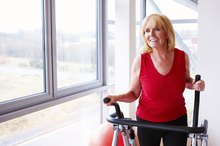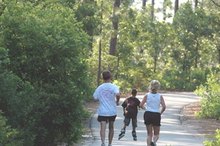What does fact checked mean?
At Healthfully, we strive to deliver objective content that is accurate and up-to-date. Our team periodically reviews articles in order to ensure content quality. The sources cited below consist of evidence from peer-reviewed journals, prominent medical organizations, academic associations, and government data.
The information contained on this site is for informational purposes only, and should not be used as a substitute for the advice of a professional health care provider. Please check with the appropriate physician regarding health questions and concerns. Although we strive to deliver accurate and up-to-date information, no guarantee to that effect is made.
Goal Setting Ideas to Improve Cardiorespiratory Endurance
Whether your goal is to be upright when you cross the finish line at your first half-marathon or simply keep up with your Saturday morning cycling crew, being in good cardiovascular shape is a necessity for endurance based activities.
But, you can’t just go from zero to the finish line in a matter of days. Building aerobic endurance takes a well-developed plan and a whole lot of patience. If you’re new to exercise, use goals based on frequency, time, and intensity to help you increase your endurance.
What is Cardiovascular Endurance?
Cardiovascular endurance or aerobic capacity is the ability of the heart and lungs to deliver oxygen to working muscles for prolonged periods of time. According to the American Heart Association, endurance activity keeps your heart, lungs and circulatory system healthy and improves your overall fitness.
Increasing your endurance makes it easier to carry out many of your everyday activities, and it also helps you reach your fitness goals faster.
Read more: Cardiorespiratory Endurance Training
- Cardiovascular endurance or aerobic capacity is the ability of the heart and lungs to deliver oxygen to working muscles for prolonged periods of time.
- According to the American Heart Association, endurance activity keeps your heart, lungs and circulatory system healthy and improves your overall fitness.
Frequency Goals
How to Lose 50 Pounds in Six Months
Learn More
In order to stave off boredom while you work on increasing your endurance, make sure to mix up your cardio sessions with different activities such as:
- running
- cycling swimming
- stair climbing
- rowing
- paddle boarding
- kickboxing
- boot camp classes
If your goal is to exercise four to five times a week, pick two or three activities that use different muscles and movements. This will help prevent chronic joint and muscle stress.
Time Goals
The Centers for Disease Control and Prevention recommends that adults should spend at least 150 minutes each week participating in moderate-intensity aerobic activity like brisk walking or riding a bike. If your goal is to improve your cardiovascular endurance, consider doubling that amount of time. But remember, you can’t just aim for 300 minutes right out of the starting gate.
Instead, start with 150 minutes each week, with a goal of adding time to each daily session. For example, if your overall goal is to improve your 5k time, you might run 30 minutes on Monday, ride an upright bike for 40 minutes on Wednesday, swim 45 minutes on Friday and then run 35 minutes on Sunday. The variety of activities and time, allows you to focus on your running goal, while still working your cardiovascular system with other aerobic activities.
Resist the temptation to add too much too quickly. You need to allow your body time to adapt to the increased workload. By increasing the time in small increments, you reduce the risk of injury and increase the odds that you will show up for your next workout.
Read more: Intensity Vs. Duration in Exercise
- The Centers for Disease Control and Prevention recommends that adults should spend at least 150 minutes each week participating in moderate-intensity aerobic activity like brisk walking or riding a bike.
- Instead, start with 150 minutes each week, with a goal of adding time to each daily session.
Intensity Goals
How Many Calories Does 10,000 Steps Burn?
Learn More
The principle of intensity is quite simple: The more intensely you exercise, the more benefits you can gain. In general, you must challenge your body to perform at an intensity that is slightly higher than your normal exertion level.
Make a goal of increasing the intensity each week by adding in high-intensity interval training, which, according to the American College of Sports Medicine, has been shown to improve aerobic fitness. Other methods that help increase your cardiovascular endurance include Tabata training, sprints and hill running.
Since high-intensity workouts are more exhaustive, a longer recovery period is often needed. That’s why the key to training with a higher intensity is to do it in moderation. In other words, every workout should not be done at a high intensity. Instead, start with one higher intensity workout a week — with your other workouts being of moderate intensity. Then add another 20- to 30-minute session the following week, until you can comfortably do two to three higher-intensity workouts per week.
A sample workout might include 20 minutes of intervals on the treadmill, alternating between one minute of sprints and one minute of walking. Or take your training outside for a track workout that combines jogging, sprints, stairs, and walking lunges.
- The principle of intensity is quite simple: The more intensely you exercise, the more benefits you can gain.
- A sample workout might include 20 minutes of intervals on the treadmill, alternating between one minute of sprints and one minute of walking.
Related Articles
References
- MayoClinic.com: Aerobic Exercise - Top 10 Reasons to Get Physical
- Brian Mac: Heart Rate Training Zones
- Patel H, Alkhawam H, Madanieh R, Shah N, Kosmas CE, Vittorio TJ. Aerobic vs anaerobic exercise training effects on the cardiovascular system. World J Cardiol. 2017;9(2):134-138. doi:10.4330/wjc.v9.i2.134
- Artioli GG, Bertuzzi RC, Roschel H, Mendes SH, Lancha AH Jr, Franchini E. Determining the contribution of the energy systems during exercise. J Vis Exp. 2012;(61):3413. doi:10.3791/3413
- Enoka RM, Duchateau J. Muscle fatigue: What, why and how it influences muscle function. J Physiol. 2008;586(1):11-23. doi:10.1113/jphysiol.2007.139477
- Smirmaul BP, Bertucci DR, Teixeira IP. Is the VO2max that we measure really maximal?. Front Physiol. 2013;4:203. doi:10.3389/fphys.2013.00203
- Lee HT, Roh HL, Kim YS. Cardiorespiratory endurance evaluation using heart rate analysis during ski simulator exercise and the Harvard step test in elementary school students. J Phys Ther Sci. 2016;28(2):641–645. doi:10.1589/jpts.28.641
- Joyner MJ, Coyle EF. Endurance exercise performance: The physiology of champions. J Physiol. 2008;586(1):35-44. doi:10.1113/jphysiol.2007.143834
- Wilmore JH, Costill DL. Physiology of Sport and Exercise: 7th Edition. Human Kinetics Publishing, 2019.
Writer Bio
Sara Lindberg, B.S., M.Ed., is a freelance health and fitness writer. She holds a Bachelor’s of Science degree in exercise science and a Master's degree in counseling. She’s spent her life educating people on the importance of health, wellness, mindset and mental health. She specializes in the mind-body connection, with a focus on how our mental and emotional wellbeing impact our physical fitness and health.








